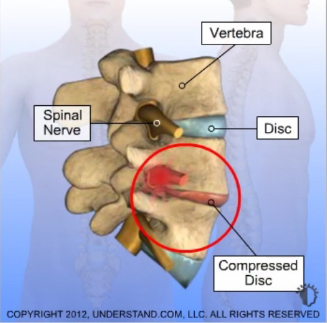The intervertebral disk is a complex structure made up of proteins and water. By the third decade of life, the nucleus propulsus or center of the disc starts to become stiff. The disc dehydrates, proteins breakdown and the disc loses its elasticity and normal compliance.
These changes increase with age and more frequently occur in the lower parts of the spine, as they have to bear more of your body’s weight. As the disc degenerates, it loses its height as well as its ability to stabilize the spine. Concurrently, portions of the disc may herniate or slip into the spinal canal resulting in sciatica or spinal stenosis. These symptoms can include pain, weakness, numbness, tingling, loss of muscle mass, difficulty walking, difficulty standing upright and inability to find a comfortable position.

As the disc degenerates, greater force is placed on the surrounding facet joints. These joints become larger to compensate for the greater force placed on them resulting in pain and further spinal stenosis. Similar changes occur with the surrounding ligaments. For minimal symptoms, the mainstay of treatment is conservative care, however, as symptoms progress or include neurologic dysfunction such as weakness and numbness, surgical intervention is recommended.

Dr. Ram R. Vasudevan, MD, FAANS
Austin NeuroSpine PLLC
5300 Bee Cave Road, Building 1,
Suite 220 Austin, TX 78746
Phone: (512) 640-0010
Monday: 8:00 AM – 5:00 PM
Tuesday: 8:00 AM – 5:00 PM
Wednesday: 8:00 AM – 5:00 PM
Thursday: 8:00 AM – 5:00 PM
Friday: 8:00 AM – 5:00 PM
Saturday: Closed
Sunday: Closed
© 2023 Austin NeuroSpine PLLC. All rights reserved.